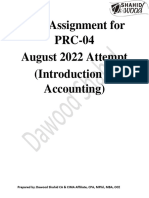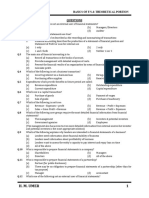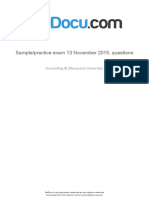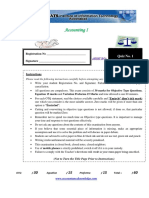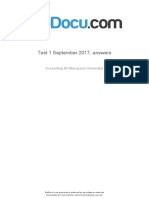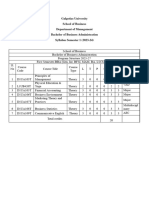Terminal Sample 1 Solved
Uploaded by
Fami FamzTerminal Sample 1 Solved
Uploaded by
Fami FamzCOMSATS Institute of Information Technology Abbottabad
Department of Management Sciences
Terminal Section A
Class: Date:
Subject: Accounting Instructor: Zaheer A. Swati
Time Allowed: 30 Minutes Max Marks: 30
Registration # Signature
SECTION-A
(Time allowed: 30 Minutes) (Marks = 30)
A. Write appropriate choice in Answer Sheet (A) (Marks 30 * 1 = 30)
1. Marketable Securities, Account Receivables and Inventory are listed as
(a) Current Asset (b) Current Liabilities (c) Long Term Asset (d) Long term liabilities
2. Which of the followings are books of prime entry?
(a) Sales day book and trial balance (b) Petty cash book and accounts receivable ledger
(c) Petty cash book and General Journal (d) Cash book and assets register
3. Which of the following would not be regarded as an asset?
(a) A piece of equipment owned by a business (b) A building that has been used by the business
(c) An inventory of goods that have yet to be sold (d) A sum of money owed to the business
4. The adjusting entry to record unpaid salaries is
(a) Salary Expense (Dr) & Cash (Cr) (b) Salary Payable (Dr) & Salary Payable (Cr)
(c) Salary Expense (Dr) & Salary Payable (Cr) (d) Salary Payable (Dr) & Cash (Cr)
5. Unearned revenue of Rs. 2,000 now earned. The entry is?
(a) Unearned revenue to revenue (b) Cash to revenue
(c) Revenue to Unearned revenue (d) None of above
6. At the end of the current accounting period, Johnson Company failed to record utilities consumed during the period. Johnson
will be billed for the utilities during the next accounting period. As a result, current period assets, liabilities, equity, and
income, respectively, are
(a) Overstated, overstated, correct, correct (b) Correct, understated, overstated, overstated
(c) Overstated, understated, overstated, overstated (d) Overstated, understated, correct, correct
7. Adjusting entries at the end of an accounting period would not be required for which of the following
(a) Multi period costs that must be split among two or more accounting periods
(b) Multi period revenues that must be split among two or more accounting periods
(c) Expenses that have been incurred in a given period but not yet recorded in the accounts
(d) Revenue that has been earned and recorded in the accounting records
8. At the end of the fiscal year, Accounts Receivable has a balance of Rs. 100,000 and Allowance for Doubtful Accounts has a
balance of Rs. 7,000. The expected net realizable value of the accounts receivable is:
(a) Rs. 100,000 (b) Rs. 93,000 (c) Rs. 107,000 (d) Rs. 7,000
www.accountancyKnowledge.com Terminal Solution
1
9. If the equipment account has a balance of Rs. 22,500 and its accumulated depreciation account has a balance of Rs. 14,000,
the book value of the equipment is
(a) Rs. 36,500 (b) Rs. 22,500 (c) Rs. 14,000 (d) Rs. 8,500
10. Bank reconciliation is not a
(a) Ledger account (b) Memorandum statement
(c) Reconcile records (d) Procedure to prove cash book balance
11. The check which is deposited into bank but not cleared at the end of a particular year is called
(a) Omitted check (b) Unpresented check (c) Uncredited check (d) Dishonored check
12. An amount of Rs. 1000 is debited twice in the bank statement. When overdraft as per the cash book is the starting point.
(a) Rs. 1,000 will be deducted (b) Rs. 1,000 will be added
(c) Rs. 2,000 will be deducted (d) Rs. 2,000 will be added
13. Accrued expenses are also called
(a) Accrued liabilities (b) Expenses already incurred but not yet paid
(c) Both a & b (d) None
14. External Users of Financial Accounting Information include all of the following except
(a) Line Manager (b) Labor Union (c) Investors (d) General Public
15. An overstatement of closing inventory in one period results in:
(a) No effect on net income (b) An overstatement of net income
(c) An understatement of net income (d) An overstatement of the closing inventory of the next period
16. Which one of the following is an example of current Liability?
(a) Bank overdraft (b) Fixtures (c) Shares (d) Long term Bank Loan
17. Which account would be listed on a post-closing trial balance,
(a) A revenue account (b) The Amortization account
(c) The Discount allowed account (d) None of Above
18. Ahmed gives a cash discount of 40 to a customer. The discount is credited in Ahmed’s book. The effect of recording the
discount in this way is that profit will be
(a) Correct (b) Overstated by 80 (c) Understated by 80 (d) Understated by 40
19. A business received cash of Rs. 3,000 in advance for the service that will be provided later. At the end of the period Rs. 1,100
is still unearned. The adjusting entry for the situation well be
(a) Debit ‘Unearned Revenue’ and Credit ‘Revenue’ for Rs. 1,900
(b) Debit ‘Unearned Revenue’ and Credit ‘Revenue’ for Rs. 1,100
(c) Debit ‘Revenue’ and Credit ‘Unearned Revenue’ for Rs. 1,100
(d) Debit ‘Revenue’ and Credit ‘Unearned Revenue’ for Rs. 1,900
20. The first item listed under current liabilities is usually?
(a) Notes payable (b) Accounts payable (c) Salaries payable (d) Taxes payable
21. An overstatement of closing inventory in one period results in?
(a) No effect on net income (b) An overstatement of net income
(c) An understatement of net income (d) An overstatement of the closing inventory of the next period
www.accountancyKnowledge.com Terminal Solution
2
22. Which one of the following is an example of current Liability?
(a) Bank overdraft (b) Fixtures (c) Shares (d) Long term Bank Loan
23. At the end of the fiscal year, Accounts Receivable has a balance of $100,000 and Allowance for Doubtful Accounts has a
balance of $7,000. The expected net realizable value of the accounts receivable is:
(a) $ 100,000 (b) $ 93,000 (c) $ 107,000 (d) $ 7,000
24. The transactions of the following must be kept separate from the personal activities of the owners for accounting purposes?
(a) Proprietorship (b) Partnership (c) Corporation (d) Both a and b above
25. The payment of cash to supplier will?
(a) Reduce cash balance and reduce current liabilities (b) Increase receivables and reduce cash balance
(c) Reduce account payable and increase purchases (d) Increase payable and reduce cash balance
26. The effect of a credit entry on the payables account is to?
(a) Decrease the account balance (b) Decrease & increase the account balance
(c) Decrease or increase the account balance (d) Increase the account balance
27. Which of the following would not be regarded as an asset?
(a) A piece of equipment owned by a business (b) A building that has been used by the business
(c) An inventory of goods that have yet to be sold (d) A sum of money owed to the business
28. Which one of the following is not true for Profit & Loss Account?
(a) It shows whether a business has made a profit or loss over a financial year
(b) It shows the financial position of a business for the period
(c) It shows revenues and expenses for the period
(d) It is used to calculate surplus/deficit for a particular period
29. Which of the following is/are not shown in balance sheet?
(a) Fixed assets (b) Current liabilities (c) Profit sharing ratio (d) Long term assets
30. Specific business entity separate from personnel affair of the owner is?
(a) Objectivity principle (b) Stable currency principle
(c) Entity principle (d) Matching principle
Best of Luck
www.accountancyKnowledge.com Terminal Solution
3
COMSATS Institute of Information Technology Abbottabad
Department of Management Sciences
Terminal Section B & C
Class: Date:
Subject: Accounting Instructor: Zaheer A. Swati
Total Time Allowed: 150 Minutes Max Marks: 70
Registration # Signature
SECTION-B
(Attempt all four questions, all questions carry equal marks 10 * 4 = 40)
Q1. From the following particulars write up the Cash Book for Muhammad Huzaifa Umar Trading Co. for the month of
June 2016 (Time should use 25 minutes).
2016
June 1 Favourable Cash Balance Rs. 18,000; Bank balance Overdraft Rs. 37,000
4 Paid Wages Rs. 200 by cash and Rent by check Rs. 1,000
6 Total sales of worth Rs. 10,000 in which 3,000 apply to credit customers Mr. Ali
9 Owner further investment Rs. 13,000, of which Rs. 10,000 was banked and the balance was retained
11 Received a check from Mr. Kazmi and deposited into the bank of worth Rs. 16,000
14 Withdrew from bank for office purpose Rs. 4,000 and for owner domestic use Rs. 2,000
18 Received check from Mr. Hamid of Rs. 22,000 and was not deposited in same date
21 Dated 6th June, 2010 Mr. Ali sent 3,000 check which was deposited in same date
23 Mr. Kazmi check of Dated 11th, June, 2010 was dishonoured and return by bank
28 Mr. Hamid check received on 18th June, 2010 were deposited into bank
30 Discount Received Rs. 300 and Discount allowed Rs. 200
Muhammad Huzaifa Umar TRADING CO.
Cash Book
For the month ended June, 2016
Receipts Payments
Date Description Ref Cash Bank Dis Date Description Ref Cash Bank Dis
2016 2016
June 1 Balance b/d 18,000 Oct 1 Balance b/d 37,000
6 Sales 7,000 4 Wages 200
9 Owner Equity 3,000 10,000 4 Rent 1,000
11 Mr. Kamal 16,000 14 Cash (c) 4,000
14 Bank (c) 4,000 14 Drawing 2,000
18 Mr. Hamid 22,000 23 Dishonoured 16,000
21 Mr. Ali 3,000 28 Bank (c) 22,000
28 Cash (c) 22,000 30 Discount 300
30 Discount 200
Balance c/d 9,000 Balance c/d 31.800
54,000 50,000 200 54,000 50,000 300
July 1 Balance b/d 31.800 July 1 Balance b/d 9,000
www.accountancyKnowledge.com 4 Terminal Solution
Q2. Make corrected Trial Balance after anticipating hidden errors for Amina Ghalib Khan Ltd. Financial year for this
company is July 1st, 2016 to June 30th, 2017 (Time should used 25 minutes).
Amina Ghalib Khan Ltd.
Trial Balance
As on 30th June, 2017
Amount (Rs.)
S. No Heads of Accounts Dr Cr
1 Purchases 35,000
2 Factory Overhead (Applied) 1,000
3 Octri and Taxes 100
4 Rebate received 500
5 Trade Mark 55,000
6 Sales 80,000
7 Share Capital 50,000
8 Return Outward 1,600
9 Bills Owed 6,500
10 Carriage Outward 3,700
11 Inventory (1.07.2016) 10,500
12 Motor Van 25,000
13 Claims Receivables 1,500
14 Sundry Debtors 9,000
15 Return Inward 2,000
16 Leasehold Premises 3,000
17 Discount on Sales 2,000
18 Petty Cash 800
19 Stock 30-06-2017 33,300
20 Sundry Creditors 10,000
21 Suspense Account 19,700
Total Rs. 175,100 Rs. 175,100
Errors in Trial Balance:
(i) Machinery bought Rs. 3,000 posted to as Trade Mark account
(ii) Credit sales of worth Rs. 1,200 was omitted to record in the book of original entry
(iii) Repairs to Motor Van Rs. 1,500 have been debited to Motor Van account
(iv) Unearned Sales of Rs. 15,000 was incorrectly credited to Sales Account
Following accounts are used for correction and adjusting the transactions.
Sales; Unearned Sales, Motor Van; Sundry Debtors; Motor Van Expense; Machinery; Trade Mark
www.accountancyKnowledge.com 5 Terminal Solution
Amina Ghalib Khan Ltd.
Trial Balance
As on 30th June, 2017
Amount (Rs.)
S. No Heads of Accounts Dr Cr
1 Purchases (35,00 – 3,000) 35,000
2 Factory Overhead (Applied) 1,000
3 Octri and Taxes 100
4 Rebate received 500
5 Trade Mark (55,00 – 3,000) 52,000
6 Sales (80,000 + 1,200-15,000) 66,200
7 Share Capital 50,000
8 Return Outward 1,600
9 Bills Owed 6,500
10 Carriage Outward 3,700
11 Inventory (1.07.2016) 10,500
12 Motor Van (25,000 -1,500) 23,500
13 Claims Receivables 1,500
14 Sundry debtors (9,000 + 1,200) 10,200
15 Return Inward 2,000
16 Leasehold Premises 3,000
17 Discount on Sales 2,000
18 Petty Cash 800
19 Sundry Creditors 10,000
20 Motor Van Repairs 1,500
21 Machinery 3,000
22 Unearned Sales 15,000
Total Rs. 149,800 Rs. 149,800
Q3. Following Data related to Shahrukh Shakeel Manufacturing at the end of June, 2017 (Time should used 25 minutes).
Cost incurred during the period
Cost of Goods Manufactured ………………105,000 Carriage in ……………………………………… 3,000
Carriage Outward …………………………. 3,000 Direct Labour………………………………….. 16,000
Direct Material Used ………………………. 78,000 Cost of Goods Sold …………………….……… 110,000
www.accountancyKnowledge.com 6 Terminal Solution
INVENTORIES
Ending Beginning
Direct Material ………………………………………………….. 9,000 ……………………………………... 19,000
Work in Process …………………………………………………. ? ……….…………………………….. 7,400
Finished Goods ………………………………………………….. 12,000 ……………………….…………….. ?
Net Sales of Rs. 400,000, Marketing Expense 2%, Administration Expense 1 % of Net Sales and Other Expense 7,000
and Other Income is 25,000; Factory overhead is applied 60% of direct labour cost and 15,000 units were completed
during year.
Requirements:
(a) Cost of Goods Sold (b) Per Unit Cost (c) Net Profit/Loss
Shahrukh Shakeel Manufacturing
Cost of Goods Sold Statement
For the Ended June, 2017
Opening Inventory 19,000
Net Purchases (Calculated) 65,000
Carriage in 3,000
Material Available for use 87,000
Closing Inventory (9,000)
Direct Material used 78,000
Direct Labor 16,000
Prime Cost 94,000
Factory Overhead Cost Applied (16,000 * 0.60) 9,600
Total Factory Cost 103,600
Opening Work in Process 7,400
Cost of Goods to be Manufactured 111,000
Closing Work in Process (Calculated) (6,000)
Cost of Goods Manufactured 105,000
Opening Finished Goods (Calculated) 17,000
Cost of Goods to be Sold 122,000
Closing Finished Goods (12,000)
Cost of Goods Sold 110,000
Per unit Cost of goods manufactured = 105,000 / 15,000 = 7 Per Unit
Gross Profit = 400,000 - 110,000 = Rs. 290,000
Net Profit = 290,000 – (3,000 + 8,000 + 4,000 +7,000) + 25,000 = Rs. 293,000
www.accountancyKnowledge.com 7 Terminal Solution
Q4. From the following particulars of Hassan Rehman Ltd. find out the errors in cash book and bank statement by
missing method and than prepare Bank Reconciliation Statement as on 30-06-2017 (Time should used 25 Minutes).
i. The bank overdrawn as per company cash book on June 30th, 2010 was Rs. 16,000.
ii. The bank statement debited Rs. 750 for insurance premium paid on June 20, on company’s standing order, but it
was recorded by company as Rs. 570.
iii. Credit side of the cash book over cast Rs. 1,000.
iv. A checks deposited by bank of worth Rs. 45,000 but Rs. 8,000 check was not collected by bank.
v. Check issued of Rs. 20,000, but cashed prior to 30.06.2010 amounting to Rs. 17,500.
vi. Bank received dividend on behalf of company and recorded correctly but recorded twice in the cash book of Rs.
3,500.
vii. A check of Rs. 5,000 issued to vendor was dishonoured due to some technical errors of accountant.
viii. A check for Rs. 1,200 was issued by the company for purchase of stationery and was paid by the bank but not
recorded in company’s book.
ix. Bill Receivable collected by the bank directly on the behalf of company Rs. 8,000.
x. Check recorded for collection but not sent to the bank Rs. 12,000.
Hassan Rehman Ltd.
Bank Reconciliation Statement
As on June 30th, 2017
i. Balance As per Cash Book (Cr) 16,000
Add:
ii. Under Recorded 180
vi. Recorded Twice 3,500
viii. Unrecorded 1,200
iv. Uncollected 8,000
x. Not sent 12,000 24,880
40,880
Less:
iii. Over cast 1,000
vii. Dishonoured 5,000
ix. Direct Collection 8,000
v. Uncashed 2,500 (16,500)
Balance As Bank Statement (Dr) 24,380
Cash Book Bank Statement
iii. Over cast 1,000 ii. Under recorded 180 v. Uncashed 2,500 iv. Uncollected 8,000
vii. dishonoured 5,000 vi. Recorded Twice 3,500 x. Not send 12,000
ix. Direct Collection 8,000 viii. Unrecorded 1,200
www.accountancyKnowledge.com 8 Terminal Solution
SECTION-C
(Attempt any two questions, all questions carry equal marks 15 * 2 = 30)
Q1. Hashim Khan & Company purchased a factory machine of Rs. 51,000 on January 1, 2005. The machine is expected
to have a salvage value of Rs. 6,000 at the end of its 5 year useful life. During the useful life, the machine is expected to
be used for 5,000 hours. The machine was used as under
Years Hours used
2005 1,200
2006 800
2007 1,150
2008 850
2009 1,000
Required: Prepare Schedule of Depreciation on the basis of following methods (Time should used 25 minutes).
(a) Straight Line Method
(b) Units of Output Method
(c) Double Declining Balance Method
(d) Sum of Year Digit Method
Solution (a)
Cost Re sidualValue
Straight Line Method = YearsOfUsefulLife
51, 0006, 000
Straight Line Method = 5
= Rs. 9,000
Schedule of Depreciation
Years Cost Annual Depreciation Accumulated Depreciation Book Value
2005 51,000 9,000 9,000 42,000
2006 51,000 9,000 18,000 33,000
2007 51,000 9,000 27,000 24,000
2008 51,000 9,000 36,000 15,000
2009 51,000 9,000 45,000 6,000
Solution (b)
Cost Re sidualValue
Unit of Output Method = EstimatedUnitsOfOutput
51, 0006 , 000
Unit of Output Method = 5, 000
= Rs. 9 per hour
www.accountancyKnowledge.com 9 Terminal Solution
Schedule of Depreciation
Annual Accumulated Book
Years Cost Hours used Rate per hr
Depreciation Depreciation Value
2005 51,000 1,200 9.0 10,800 10,800 40,200
2006 51,000 800 9.0 7,200 18,000 33,000
2007 51,000 1,150 9.0 10,350 28,350 22,650
2008 51,000 850 9.0 7,650 36,000 15,000
2009 51,000 1,000 9.0 9,000 45,000 6,000
Solution (c)
Double Declining Rate= 1 * 2
5
Rate of Depreciation =40%
Schedule of Depreciation
Rate of Annual Accumulated
Years Cost Book Value
Depreciation Depreciation Depreciation
2005 51,000 40% 20,400 20,400 30,600
2006 51,000 40% 12,240 32,640 18,360
2007 51,000 40% 7,344 39,984 11,016
2008 51,000 40% 4,406.4 44,390.4 6,609.6
2009 51,000 40% 609.6 45,000 6,000
Solution (d)
SYD=1+2+3+4+ 5= 15
51,000-6,000= 45,000
Schedule of Depreciation
Rate of Annual Accumulated
Years Cost Book Value
Depreciation Depreciation Depreciation
2005 51,000 5/15 15,000 15,000 36,000
2006 51,000 4/15 12,000 27,000 24,000
2007 51,000 3/15 9,000 36,000 15,000
2008 51,000 2/15 6,000 42,000 9,000
2009 51,000 1/15 3,000 45,000 6,000
www.accountancyKnowledge.com 10 Terminal Solution
Q2. The following Trial Balance of Saba Nisar & Co. on December 31st, 2016, Prepare Financial Statement in horizontal
style
Particular Dr Cr Particular Dr Cr
Owner’s Equity 4,000 Note Payable 560
Account Payable 5,200 Note Receivable 720
Plant and Machinery 5,000 Return Inward 930
Office Furniture & Fittings 260 Provision for Bad Debts 250
Opening Inventory 4,800 Drawing 700
Motor Van 1,200 Return Outward 550
Account Receivables 4,570 Rent 600
Cash in Hand 40 Factory Lighting and Lighting 80
Cash at Bank 650 Insurance 630
Wages 15,000 General Expenses 100
Salaries 1,400 Bad Debts 250
Purchases 21,350 Discount 650 370
Sales 48,000 Total Rs. 58,930 Rs. 58,930
The following adjustments are to be made:
(i) Stock at the end of year Rs. 5,200 and Three months factor lighting and heating is due, but not paid Rs. 30
(ii) 5 percent depreciation to be written-off on furniture and write-off further bad debts Rs. 70
(iii) The provision for bad debts to be Rs. 300 and provision for discount on debtor @ 2 % to be made
(iv) During the year machinery was purchased for Rs. 2,000, but was debited to Purchase account
Saba Nisar & Co.
Trading and Profit & Loss Account
For the Year ended 31st, December 2016
Expenses Debit Revenue Credit
Sales
Opening Inventory 4,800 48,000
Purchases Return Inward
21,350 (930) 47,070
Returns Outward
(550) Closing Stock 5,200
Machinery Purchase
(2,000) 18,800
Wages 15,000
Gross Profit c/d 13,670
Total 52,270 Total 52,270
Salaries 1,400 Gross Profit b/d 13,670
Rent 600 Discount 370
Factory Lighting & Heating 80
Outstanding 30 110
Insurance 630
General Expenses 100
Bad Debts 250
Additional 70 320
Discount 650
www.accountancyKnowledge.com 11 Terminal Solution
Depreciation Exp. _Furniture 13
Provision for Bad Debts:
New 300
Old (250) 50
Provision for Discount on Debtor
(4,200@2%) 84
Net Profit c/f to B/S 10,083
Total Rs. 14,040 Total Rs. 14,040
Saba Nisar & Co.
Balance Sheet
As on 31st, December 2016
Equities Amount Assets Amount
Fixed and Long Term:
Owner’s Equity: Plant and Machinery 5,000
Capital 4,000 Additional 2,000 7,000
Drawing (700) Office Furniture & Fitting 260
Profit b/f 10,083 13,383 Depreciation 13 247
Motor Van 1,200
Current Liabilities: Current Assets:
Note Payable 560 Cash in Hand 40
Account Payable 5,200 Cash at Bank 650
Outstanding Factor Lighting &
Heating 30 Note Receivable 720
Account Receivable 4,570
Further B/D (70)
Provision for B/D (300)
Provision for Dis. on Debtor (84) 4,116
Closing Stock 5,200
Total Rs. 19,173 Total Rs. 19,173
Q3. Prepare Store Ledger Card (SLC) from the following information (Time should used 25 Minutes)..
2017
March 1 Beginning Inventory …………. 180 Pieces @ Rs. 30 …………………… Rs. 5,400
9 Sales ………………………….. 60 Pieces @ Rs. 45 …………………… Rs. 2,700
12 Purchases ……………..……… 50 Pieces @ Rs. 28 …………………… Rs. 1,400
18 Sale…………………………… 140 Pieces @ Rs. 60 …………………… Rs. 8,400
23 Purchases …………..…………. 80 Pieces @ Rs. 26 …………………… Rs. 2,080
24 Purchase ……………………….. 90 Pieces @ Rs. 20 ……………………. Rs. 1,800
30 Sales …………………………… 180 Pieces @ Rs. 65 …………………… Rs. 11,700
Required
Use Comparative Cost Sheet in order to determine the Cost of Sales, cost of Closing Stock, Sales and Gross profit / loss
under each of the following method by using perpetual inventory system.
a. Cost are assigned on the basis of FIFO
b. Cost are assigned on the basis of Weighted Average
www.accountancyKnowledge.com 12 Terminal Solution
Store Ledger Card (SLC) FIFO
Purchases Sales Balances
Date Description Units @ Amount Units @ Amount Units @ Amount
March 1 Balance b / f 180 30 5,400
9 Sales 60 30 1,800 120 30 3,600
12 Purchases 50 28 1,400 120 30 3,600
50 28 1,400
18 Sales 120 30 3,600
20 28 560 30 28 840
23 Purchases 80 26 2,080 30 28 840
80 26 2,080
24 Purchases 90 20 1,800 30 28 840
80 26 2,080
90 20 1,800
30 Sales 30 28 840
80 26 2,080
70 20 1,400 20 20 400
Total 220 5,280 380 10,280 20 400
www.accountanyKnowledg.com 13 Terminal Solution
Store Ledger Card (SLC) Average
Purchases Sales Balances
Date Description Units @ Amount Units @ Amount Units @ Amount
March 1 Balance b / f 180 30 5,400
9 Sales 60 30 1,800 120 30 3,600
12 Purchases 50 28 1,400 170 29.41 5,000
18 Sales 140 29.41 4117.4 30 29.41 882.6
23 Purchases 80 26 2,080 110 26.93 2,962.6
24 Purchases 90 20 1,800 200 23.81 4,762.6
30 Sales 180 23.81 4,285.8 20 23.81 476.2
Total 220 5,280 380 10,203.2 20 23.81 476.2
Comparative Cost Sheet
Methods Balance Purchases Closing Stock CGS Sales Gross Profit
FIFO 5,400 5,280 (400) 10,080 22,800 12,520
Average 5,400 5,280 (476.2) 10,203.8 22,800 12,596.2
www.accountanyKnowledg.com 14 Terminal Solution
You might also like
- Series 65 Exam Practice Question Workbook: 700+ Comprehensive Practice Questions (2024 Edition)From EverandSeries 65 Exam Practice Question Workbook: 700+ Comprehensive Practice Questions (2024 Edition)No ratings yet
- When Goods Are Purchased:: Journal Entries in A Perpetual Inventory SystemNo ratings yetWhen Goods Are Purchased:: Journal Entries in A Perpetual Inventory System27 pages
- Career Counseling For: Commerce StudentsNo ratings yetCareer Counseling For: Commerce Students36 pages
- Sample Paper: H.O.: 6, Vidya Sagar Lane, Behind Apex Mall, Indrapuri, Lal Kothi. Tonk Road, JaipurNo ratings yetSample Paper: H.O.: 6, Vidya Sagar Lane, Behind Apex Mall, Indrapuri, Lal Kothi. Tonk Road, Jaipur11 pages
- 11th-Accountancy-EM-Book-Back-1-Mark-Questions-English-Medium-PDF-DownloadNo ratings yet11th-Accountancy-EM-Book-Back-1-Mark-Questions-English-Medium-PDF-Download3 pages
- Subject: Accountancy Class: XI Time: 3 Hours Max. Marks: 80No ratings yetSubject: Accountancy Class: XI Time: 3 Hours Max. Marks: 806 pages
- namma_kalvi_12th_accountancy_book_back_1_mark_test_question_paper_em_215253No ratings yetnamma_kalvi_12th_accountancy_book_back_1_mark_test_question_paper_em_2152536 pages
- Journal, Ledger, Trail Balance and Finnancial Statement MCQs100% (9)Journal, Ledger, Trail Balance and Finnancial Statement MCQs5 pages
- 11th_EM_Accountancy_Important QuestionsNo ratings yet11th_EM_Accountancy_Important Questions31 pages
- Ac Test 80 M (1) - Watermark - WatermarkNo ratings yetAc Test 80 M (1) - Watermark - Watermark5 pages
- Namma-Kalvi-12th-Accountancy-MCQ-Question-Bank-EM-221042No ratings yetNamma-Kalvi-12th-Accountancy-MCQ-Question-Bank-EM-22104254 pages
- 7._BCM_Sec_2D1_Term_3_Holiday_homework (2)No ratings yet7._BCM_Sec_2D1_Term_3_Holiday_homework (2)9 pages
- SET A Half Yearly XI Accountancy 2023-24No ratings yetSET A Half Yearly XI Accountancy 2023-245 pages
- Gat Subject Management Sciences Accounting Mcqs1 50No ratings yetGat Subject Management Sciences Accounting Mcqs1 505 pages
- Sample QP For Grade 11 ACC Model Examination 2024No ratings yetSample QP For Grade 11 ACC Model Examination 20249 pages
- DoE Practice Paper 2025 Gr11--AccountancyNo ratings yetDoE Practice Paper 2025 Gr11--Accountancy14 pages
- CPT Question Paper December 2016 With Answer Key PDFNo ratings yetCPT Question Paper December 2016 With Answer Key PDF28 pages
- Registration No: Q1. Multiple Choice Questions (Marks 10)No ratings yetRegistration No: Q1. Multiple Choice Questions (Marks 10)4 pages
- Sample/practice Exam 13 November 2015, Questions Sample/practice Exam 13 November 2015, QuestionsNo ratings yetSample/practice Exam 13 November 2015, Questions Sample/practice Exam 13 November 2015, Questions19 pages
- Accounting 1 MGT: Registration No - SignatureNo ratings yetAccounting 1 MGT: Registration No - Signature6 pages
- Test 1 September 2017, Answers Test 1 September 2017, AnswersNo ratings yetTest 1 September 2017, Answers Test 1 September 2017, Answers7 pages
- Prepare: Cash and Signs A Note For The BalanceNo ratings yetPrepare: Cash and Signs A Note For The Balance1 page
- PPT VER Topic 3 Accounting Concepts and PrinciplesNo ratings yetPPT VER Topic 3 Accounting Concepts and Principles3 pages
- Service Concession Arrangements: Disclosures: SIC Interpretation 29No ratings yetService Concession Arrangements: Disclosures: SIC Interpretation 296 pages
- Assessment of Internal Audit Practice (A Case of Finance and Economic Development Office in Adama Town)No ratings yetAssessment of Internal Audit Practice (A Case of Finance and Economic Development Office in Adama Town)49 pages
- Las Normas Niif Ilustradas Emitidas Parte ANo ratings yetLas Normas Niif Ilustradas Emitidas Parte A12 pages
- Group 2 - Jollibee Foods Corporation 2019 Financial Report0% (1)Group 2 - Jollibee Foods Corporation 2019 Financial Report15 pages
- AP&P I-Chapter - 7 - Auditing & Auditor in EthiopiaNo ratings yetAP&P I-Chapter - 7 - Auditing & Auditor in Ethiopia14 pages
- 2021 - FAR Straight Problem Answer SheetNo ratings yet2021 - FAR Straight Problem Answer Sheet11 pages
- Series 65 Exam Practice Question Workbook: 700+ Comprehensive Practice Questions (2024 Edition)From EverandSeries 65 Exam Practice Question Workbook: 700+ Comprehensive Practice Questions (2024 Edition)
- When Goods Are Purchased:: Journal Entries in A Perpetual Inventory SystemWhen Goods Are Purchased:: Journal Entries in A Perpetual Inventory System
- Sample Paper: H.O.: 6, Vidya Sagar Lane, Behind Apex Mall, Indrapuri, Lal Kothi. Tonk Road, JaipurSample Paper: H.O.: 6, Vidya Sagar Lane, Behind Apex Mall, Indrapuri, Lal Kothi. Tonk Road, Jaipur
- 11th-Accountancy-EM-Book-Back-1-Mark-Questions-English-Medium-PDF-Download11th-Accountancy-EM-Book-Back-1-Mark-Questions-English-Medium-PDF-Download
- Subject: Accountancy Class: XI Time: 3 Hours Max. Marks: 80Subject: Accountancy Class: XI Time: 3 Hours Max. Marks: 80
- namma_kalvi_12th_accountancy_book_back_1_mark_test_question_paper_em_215253namma_kalvi_12th_accountancy_book_back_1_mark_test_question_paper_em_215253
- Journal, Ledger, Trail Balance and Finnancial Statement MCQsJournal, Ledger, Trail Balance and Finnancial Statement MCQs
- Namma-Kalvi-12th-Accountancy-MCQ-Question-Bank-EM-221042Namma-Kalvi-12th-Accountancy-MCQ-Question-Bank-EM-221042
- Gat Subject Management Sciences Accounting Mcqs1 50Gat Subject Management Sciences Accounting Mcqs1 50
- CPT Question Paper December 2016 With Answer Key PDFCPT Question Paper December 2016 With Answer Key PDF
- Cash & Investment Management for Nonprofit OrganizationsFrom EverandCash & Investment Management for Nonprofit Organizations
- Registration No: Q1. Multiple Choice Questions (Marks 10)Registration No: Q1. Multiple Choice Questions (Marks 10)
- Sample/practice Exam 13 November 2015, Questions Sample/practice Exam 13 November 2015, QuestionsSample/practice Exam 13 November 2015, Questions Sample/practice Exam 13 November 2015, Questions
- Test 1 September 2017, Answers Test 1 September 2017, AnswersTest 1 September 2017, Answers Test 1 September 2017, Answers
- PPT VER Topic 3 Accounting Concepts and PrinciplesPPT VER Topic 3 Accounting Concepts and Principles
- Service Concession Arrangements: Disclosures: SIC Interpretation 29Service Concession Arrangements: Disclosures: SIC Interpretation 29
- Assessment of Internal Audit Practice (A Case of Finance and Economic Development Office in Adama Town)Assessment of Internal Audit Practice (A Case of Finance and Economic Development Office in Adama Town)
- Group 2 - Jollibee Foods Corporation 2019 Financial ReportGroup 2 - Jollibee Foods Corporation 2019 Financial Report
- AP&P I-Chapter - 7 - Auditing & Auditor in EthiopiaAP&P I-Chapter - 7 - Auditing & Auditor in Ethiopia

















































